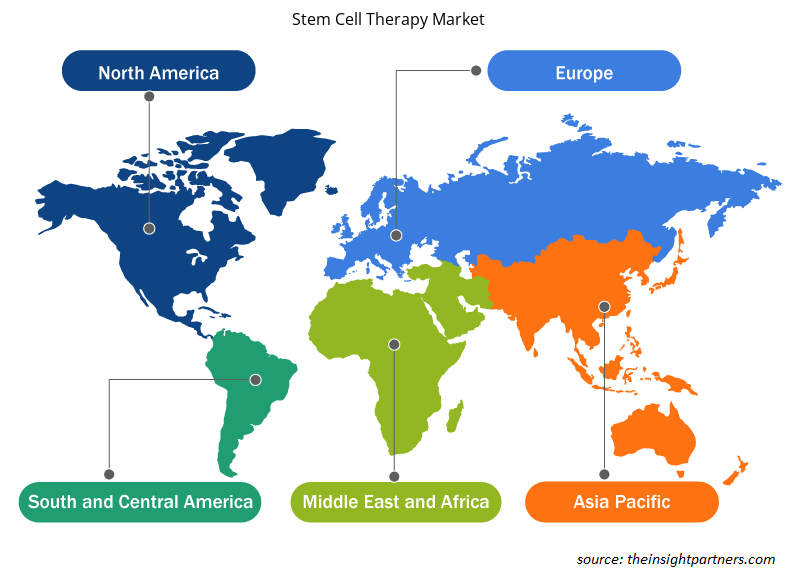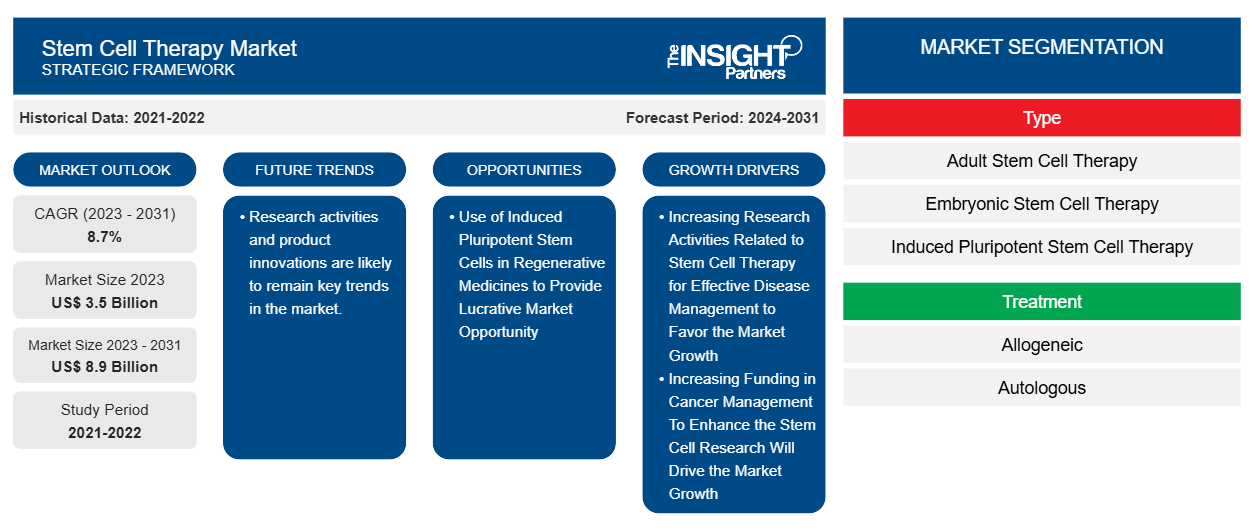Si prevede che la dimensione del mercato della terapia con cellule staminali raggiungerà gli 8,9 miliardi di dollari entro il 2031, rispetto ai 3,5 miliardi di dollari del 2023. Si prevede che il mercato registrerà un CAGR dell'8,7% nel periodo 2023-2031. È probabile che le attività di ricerca e le innovazioni di prodotto rimangano tendenze chiave nel mercato.
Analisi di mercato della terapia con cellule staminali
Le attività di ricerca e le innovazioni di prodotto probabilmente rimarranno tendenze chiave nel mercato. Un rapporto di EuroGCT rivela che il trapianto di cellule staminali del sangue si dimostra efficace nel trattamento di tipi di cancro del sangue come leucemia, linfoma e mieloma; sindrome mielodisplastica; e disturbi mieloproliferativi. Inoltre, i trapianti di cellule staminali del sangue hanno dimostrato clinicamente di trattare l'immunodeficienza combinata grave (SCID) sostituendo le cellule immunitarie difettose con cellule donatrici sane. Pertanto, le attività di ricerca e l'innovazione di prodotto sono un fattore influente responsabile della considerevole crescita del mercato nel periodo 2021-2031.
Panoramica del mercato della terapia con cellule staminali
L'aumento dei finanziamenti o degli investimenti migliorerà la ricerca sulle cellule staminali. Nel 2023, la Lee Shau Kee Foundation con sede a Hong Kong per l'Institute for Regeneration and Repair (IRR) dell'Università ha ricevuto 10,82 milioni di dollari per potenziare la ricerca sulle cellule staminali e l'ingegneria tissutale dell'Università. Il fondo sosterrà il programma di collaborazione internazionale in biologia delle cellule staminali che aiuterà l'IRR a lavorare per affrontare malattie come disfunzione cronica degli organi, traumi e condizioni congenite e genetiche. Pertanto, l'aumento dei finanziamenti o degli investimenti accelererà la domanda di terapia con cellule staminali nel prossimo decennio.
Personalizza questo report in base alle tue esigenze
Riceverai la personalizzazione gratuita di qualsiasi report, comprese parti di questo report, o analisi a livello nazionale, pacchetto dati Excel, oltre a usufruire di grandi offerte e sconti per start-up e università
-
Scopri le principali tendenze di mercato in questo rapporto.Questo campione GRATUITO includerà analisi di dati che spaziano dalle tendenze di mercato alle stime e alle previsioni.
Driver e opportunità del mercato della terapia con cellule staminali
Aumento delle attività di ricerca relative alla terapia con cellule staminali per una gestione efficace delle malattie a favore del mercato
La terapia con cellule staminali è stata ampiamente studiata a livello globale poiché le cellule staminali sono utilizzate principalmente per sostituire le cellule morenti e ricostruire i tessuti danneggiati. Sulla base dei risultati clinici condotti dagli scienziati mirati alle cellule staminali, si sostiene che queste cellule potrebbero probabilmente essere utilizzate per generare trattamenti specifici per diverse malattie come il cancro e le malattie cardiovascolari. Inoltre, le terapie con cellule staminali sviluppate comportano la sostituzione delle cellule patogene con cellule staminali. I ricercatori stanno ulteriormente studiando l'uso della terapia con cellule staminali per trattare i disturbi autoimmuni. Pertanto, l'aumento delle attività di ricerca relative alla terapia con cellule staminali per una gestione efficace delle malattie è uno dei principali motori della quota di mercato globale della terapia con cellule staminali.
L'uso di cellule staminali pluripotenti indotte nella medicina rigenerativa offre opportunità di mercato redditizie
Secondo il rapporto Frontiers Media SA 2023, i progressi nel campo delle cellule staminali pluripotenti indotte (iPSC) hanno aperto nuovi canali per la ricerca in campo terapeutico. Le iPSC sono principalmente destinate alla ricerca e agli studi clinici per la modellazione delle malattie, la medicina rigenerativa e gli studi sulla scoperta di farmaci/citotossicità dei farmaci. Ad esempio, le iPSC possono essere utilizzate per convertire le cellule somatiche differenziate in cellule staminali multipotenti per generare diversi tipi di cellule di tessuti adulti. Pertanto, le iPSC hanno mostrato risultati promettenti nella medicina rigenerativa, in particolare per sostituire cellule malate o danneggiate. Pertanto, studi come la scoperta di farmaci che coinvolgono lo screening di piccole molecole e test di tossicità per la valutazione della sicurezza sono stati divulgati con successo. È probabile che i risultati positivi basati sulle iPSC creino opportunità redditizie per gli operatori del mercato della terapia con cellule staminali nei prossimi anni.
Analisi della segmentazione del rapporto di mercato sulla terapia con cellule staminali
I segmenti chiave che hanno contribuito alla derivazione dell'analisi di mercato della terapia con cellule staminali sono tipologia, trattamento, applicazione e utente finale.
- In base al tipo, il mercato della terapia con cellule staminali è segmentato in terapia con cellule staminali adulte, terapia con cellule staminali embrionali, terapia con cellule staminali pluripotenti indotte e altre terapie con cellule staminali. Il segmento della terapia con cellule staminali adulte ha detenuto una quota di mercato maggiore nel 2023.
- In base al trattamento, il mercato è diviso in allogenico e autologo. Il segmento allogenico ha detenuto la quota maggiore del mercato nel 2023.
- Per applicazione, il mercato è segmentato in muscoloscheletrico, dermatologia , cardiologia, scoperta e sviluppo di farmaci e altre applicazioni. Il segmento di scoperta e sviluppo di farmaci ha detenuto la quota maggiore del mercato nel 2023.
- In base all'utente finale, il mercato è segmentato in ospedali e cliniche specialistiche e istituti accademici e di ricerca. Il segmento degli istituti accademici e di ricerca ha detenuto la quota maggiore del mercato nel 2023.
Analisi della quota di mercato della terapia con cellule staminali per area geografica
L'ambito geografico del rapporto di mercato sulla terapia con cellule staminali è suddiviso principalmente in cinque regioni: Nord America, Asia Pacifico, Europa, Medio Oriente e Africa, Sud e Centro America.
Il Nord America ha dominato il mercato. Nella regione del Nord America, gli Stati Uniti rappresentano la quota maggiore del mercato della terapia con cellule staminali. La presenza dei principali produttori nella regione e le elevate attività di ricerca e sviluppo (R&S) sono i fattori che contribuiscono al predominio del mercato. Si prevede che l'Asia Pacifica crescerà con il CAGR più elevato nei prossimi anni.
Approfondimenti regionali sul mercato della terapia con cellule staminali
Le tendenze regionali e i fattori che influenzano il mercato della terapia con cellule staminali durante il periodo di previsione sono stati ampiamente spiegati dagli analisti di Insight Partners. Questa sezione discute anche i segmenti e la geografia del mercato della terapia con cellule staminali in Nord America, Europa, Asia Pacifico, Medio Oriente e Africa e Sud e Centro America.

- Ottieni i dati specifici regionali per il mercato della terapia con cellule staminali
Ambito del rapporto di mercato sulla terapia con cellule staminali
| Attributo del report | Dettagli |
|---|---|
| Dimensioni del mercato nel 2023 | 3,5 miliardi di dollari USA |
| Dimensioni del mercato entro il 2031 | 8,9 miliardi di dollari USA |
| CAGR globale (2023-2031) | 8,7% |
| Dati storici | 2021-2022 |
| Periodo di previsione | 2024-2031 |
| Segmenti coperti |
Per tipo
|
| Regioni e Paesi coperti |
America del Nord
|
| Leader di mercato e profili aziendali chiave |
|
Densità degli attori del mercato della terapia con cellule staminali: comprendere il suo impatto sulle dinamiche aziendali
Il mercato della terapia con cellule staminali sta crescendo rapidamente, spinto dalla crescente domanda degli utenti finali dovuta a fattori quali l'evoluzione delle preferenze dei consumatori, i progressi tecnologici e una maggiore consapevolezza dei benefici del prodotto. Con l'aumento della domanda, le aziende stanno ampliando le loro offerte, innovando per soddisfare le esigenze dei consumatori e capitalizzando sulle tendenze emergenti, il che alimenta ulteriormente la crescita del mercato.
La densità degli operatori di mercato si riferisce alla distribuzione di aziende o società che operano in un particolare mercato o settore. Indica quanti concorrenti (operatori di mercato) sono presenti in un dato spazio di mercato in relazione alle sue dimensioni o al valore di mercato totale.
Le principali aziende che operano nel mercato della terapia con cellule staminali sono:
- MEDIPOST
- Fonte ricca
- BioTime, Inc
- Mesoblast limitato
- Holostem Terapie Avanzate Srl
- Cellule staminali statunitensi, Inc.
Disclaimer : le aziende elencate sopra non sono classificate secondo un ordine particolare.

- Ottieni una panoramica dei principali attori del mercato della terapia con cellule staminali
Notizie e sviluppi recenti sul mercato della terapia con cellule staminali
Il mercato della terapia con cellule staminali viene valutato raccogliendo dati qualitativi e quantitativi post-ricerca primaria e secondaria, che includono importanti pubblicazioni aziendali, dati di associazioni e database. Di seguito sono elencati alcuni degli sviluppi nel mercato della terapia con cellule staminali:
- Allogene Therapeutics, Inc. ha annunciato che la Food and Drug Administration (FDA) statunitense ha concesso la designazione Fast Track ad "ALLO-605". Il prodotto appena concesso è la terapia AlloCAR T di nuova generazione dell'azienda per il trattamento del mieloma multiplo recidivante o refrattario. La FDA ha concesso la designazione Fast Track in base al potenziale di ALLO-605 di rispondere alle esigenze insoddisfatte dei pazienti che hanno fallito altre terapie standard per il mieloma multiplo. (Fonte: Allogene Therapeutics, Inc., sito Web aziendale, giugno 2021)
Copertura e risultati del rapporto sul mercato della terapia con cellule staminali
Il rapporto "Dimensioni e previsioni del mercato della terapia con cellule staminali (2021-2031)" fornisce un'analisi dettagliata del mercato che copre le seguenti aree:
- Dimensioni e previsioni del mercato della terapia con cellule staminali a livello globale, regionale e nazionale per tutti i principali segmenti di mercato coperti dall'ambito
- Tendenze del mercato della terapia con cellule staminali e dinamiche di mercato come fattori trainanti, limitazioni e opportunità chiave
- Analisi dettagliata delle cinque forze PEST/Porter e SWOT
- Analisi di mercato della terapia con cellule staminali che copre le principali tendenze del mercato, il quadro globale e regionale, i principali attori, le normative e i recenti sviluppi del mercato
- Analisi del panorama industriale e della concorrenza che copre la concentrazione del mercato, l'analisi della mappa di calore, i principali attori e gli sviluppi recenti per il mercato della terapia con cellule staminali
- Profili aziendali dettagliati
- Analisi storica (2 anni), anno base, previsione (7 anni) con CAGR
- Analisi PEST e SWOT
- Valore/volume delle dimensioni del mercato - Globale, Regionale, Nazionale
- Industria e panorama competitivo
- Set di dati Excel
Report recenti
Rapporti correlati
Testimonianze
Motivo dell'acquisto
- Processo decisionale informato
- Comprensione delle dinamiche di mercato
- Analisi competitiva
- Analisi dei clienti
- Previsioni di mercato
- Mitigazione del rischio
- Pianificazione strategica
- Giustificazione degli investimenti
- Identificazione dei mercati emergenti
- Miglioramento delle strategie di marketing
- Aumento dell'efficienza operativa
- Allineamento alle tendenze normative























 Ottieni un campione gratuito per - Mercato della terapia con cellule staminali
Ottieni un campione gratuito per - Mercato della terapia con cellule staminali